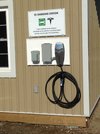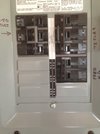Yeah, that sounds like a fine plan.So I just bought a brand new home and the garage came wired with 8/2 wire but no outlet. I plan on installing a NEMA 6-50 with a 40a breaker since the wire is only 8/2 and I will be charging at 30amps. Should be okay right?
Seems odd. I mean mine is like that. But only because I had an electrician disconnect a dedicated arc welding plug in the garage so I could free up breakers in the panel to reuse for a home remodel since I don’t use an arc welder.
You need to have someone check and make sure there is NOTHING else on that line as well before you go any further.
It's not odd really for a newly built house/garage. Many states are instituting requirements to pre-wire for being "EV Ready". Different states have different requirements for that. Some specify to put an outlet on, some not. But regardless, they need to get the wire in the wall before the sheet rock goes up, because that's the expensive part to retrofit later.In a newly built house, it is a California Title 24 thing.
Yes, it is legal--because of this:But it's not legal because someone could plug in a higher power device and be driven so mad by the nuisance trips that they end up snapping and doing something stupid. Otherwise, the worst case scenario is the very small chance that an inspector might uncover your crime when you sell the house and force you to change the outlet and breaker to 30A versions.
There is a specific code provision that allows this.It's actually perfectly legal. Because there is no specific 40a NEMA outlet, you are allowed to use a 50a outlet on a 40a circuit. It's a very common installation in the rest of the EV world of largely 30a EVSEs.
And I think that may be one of the reasons why Tesla made the 2nd gen mobile connector only run at 32A max. There are a lot of these 50A outlet types on 40A circuits, and they did not want to be the cause of any problems of people drawing 40A from a 40A circuit, and risking problems if faulty breakers didn't cut that off.




